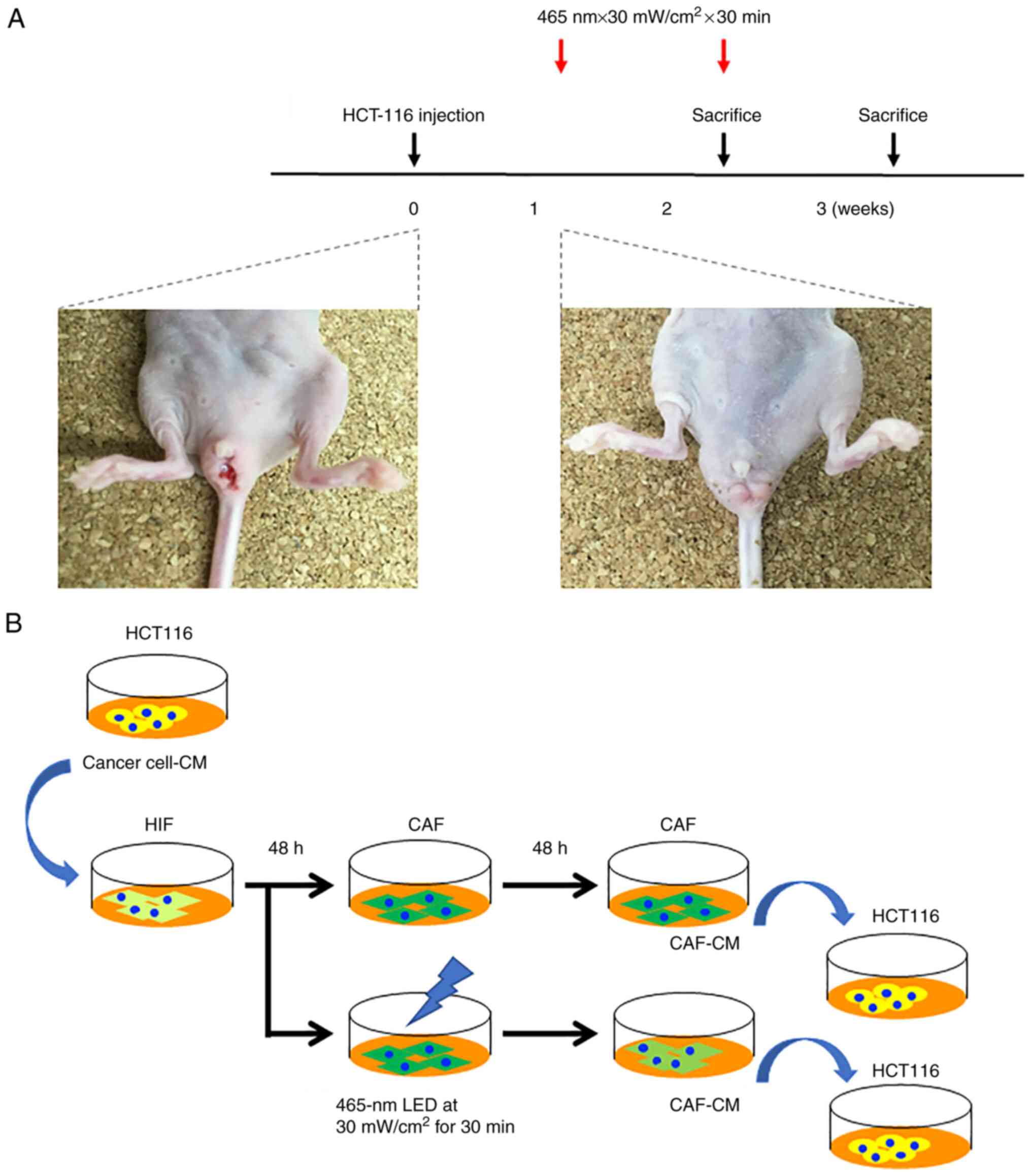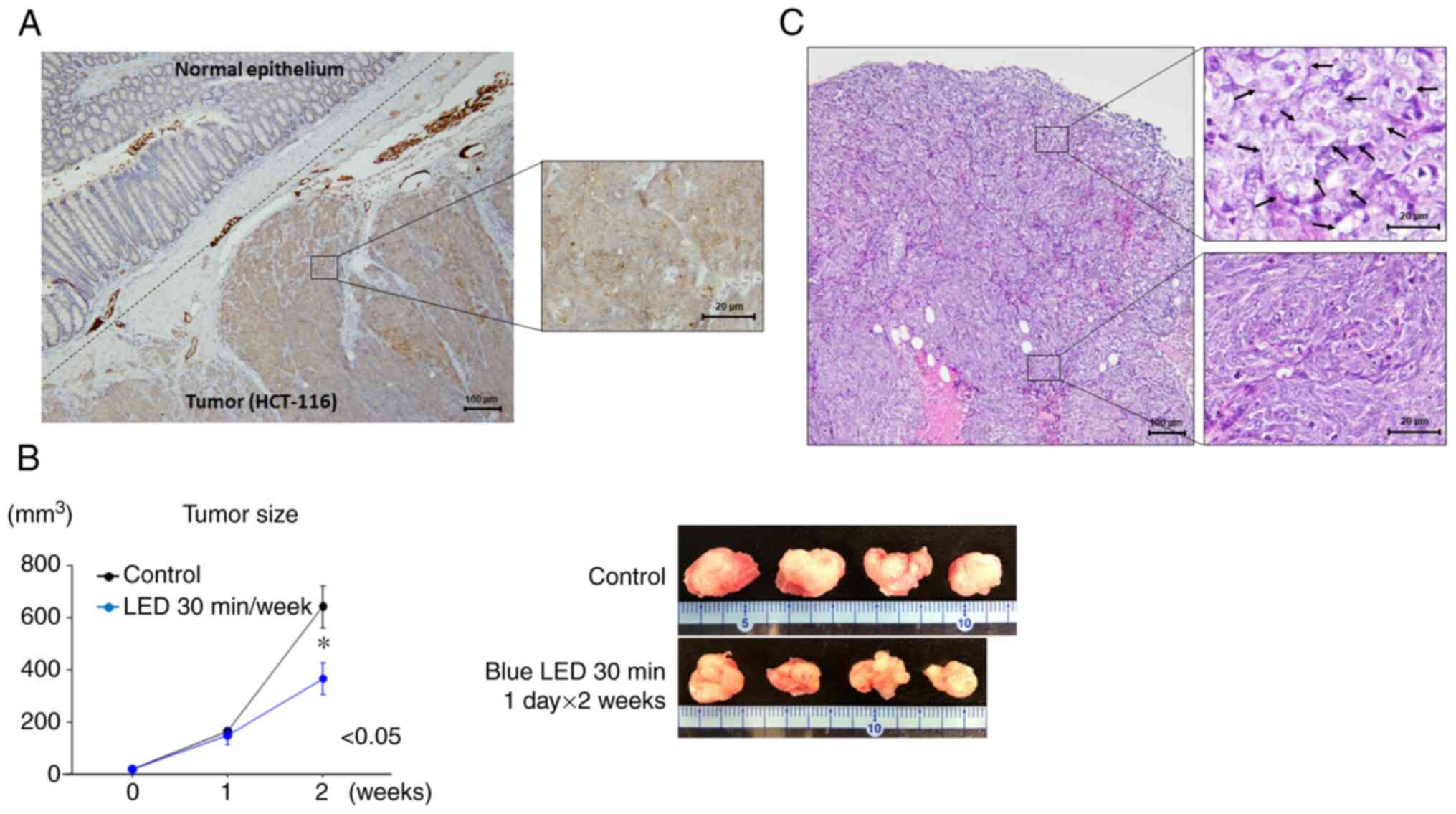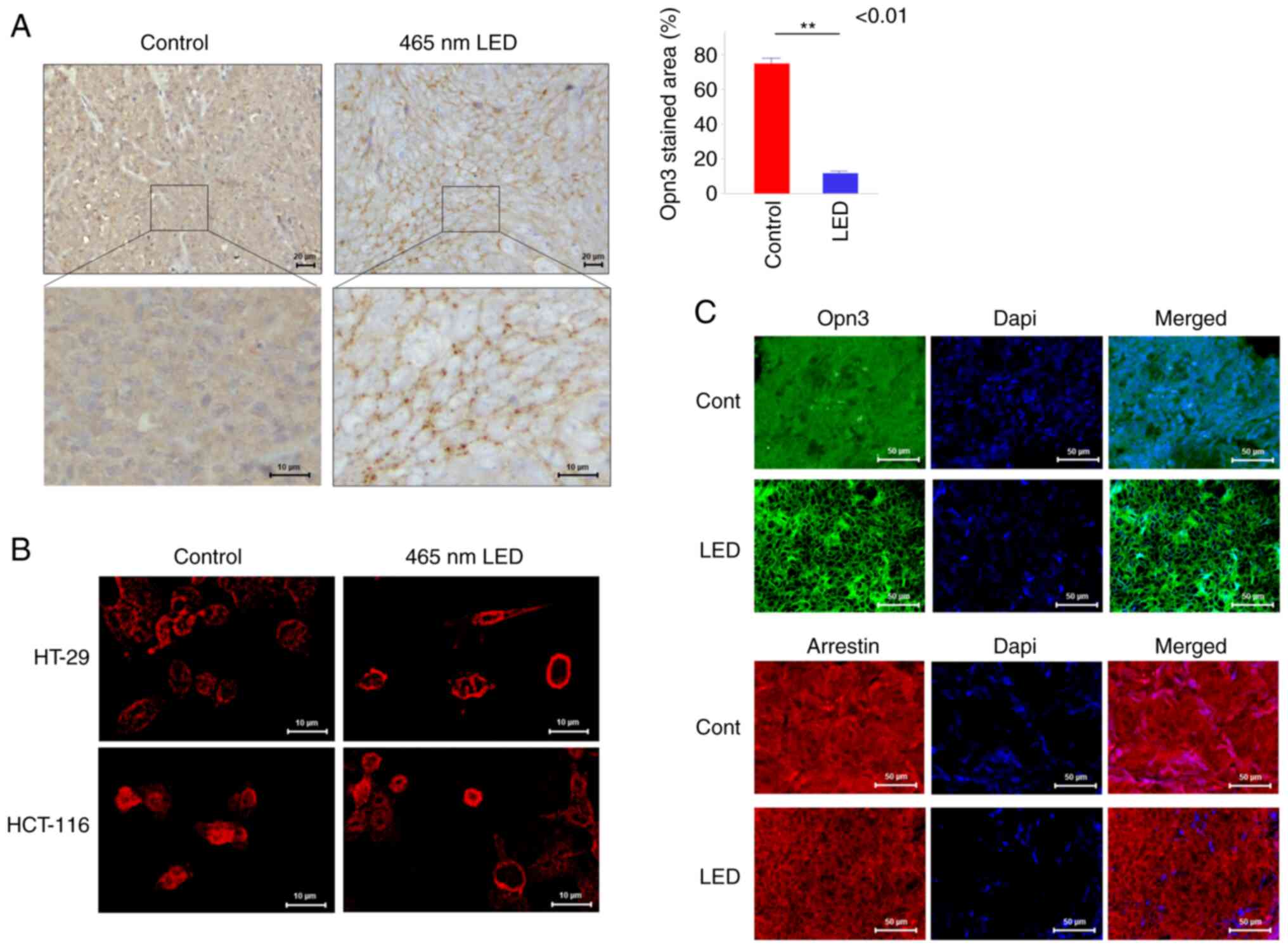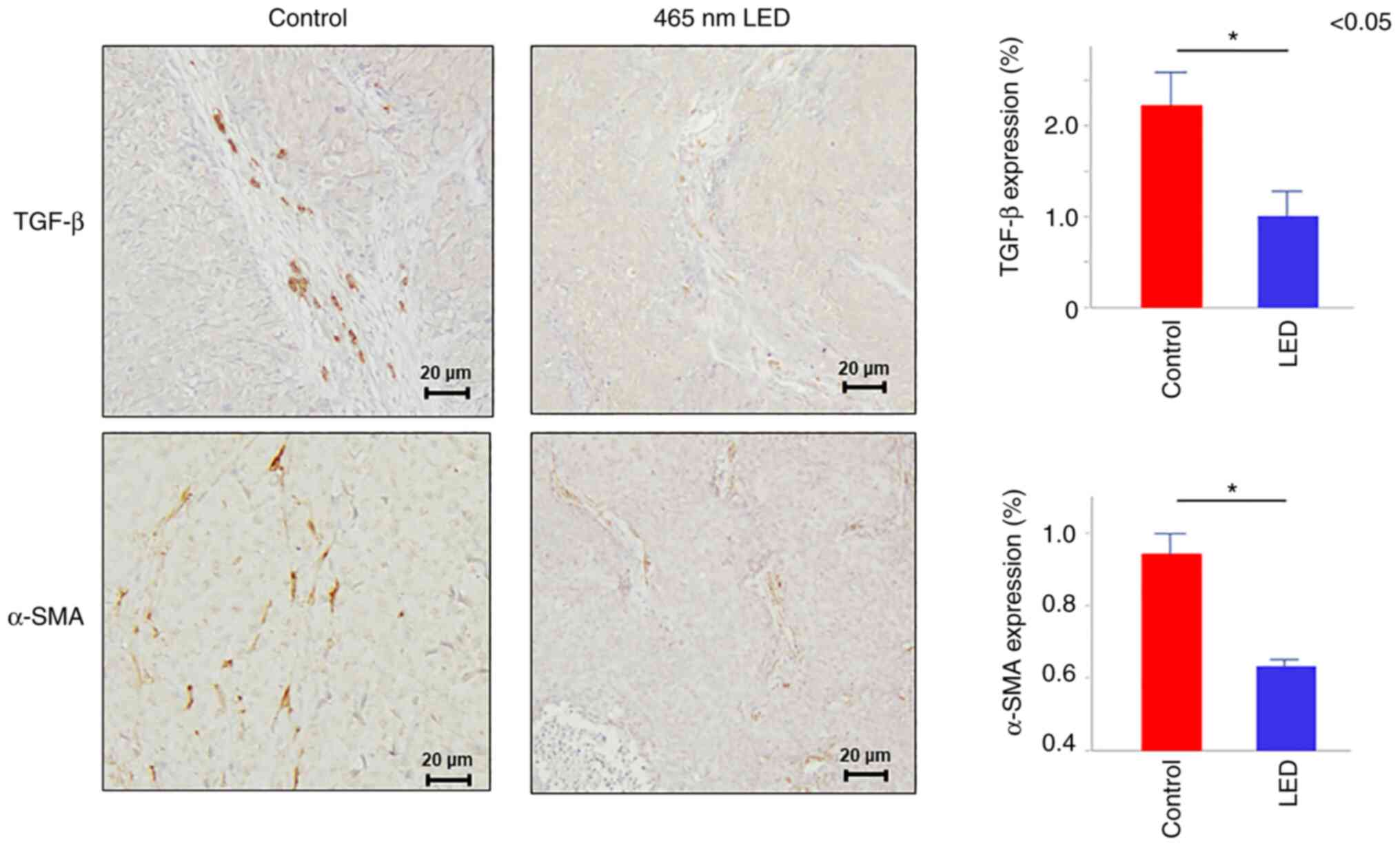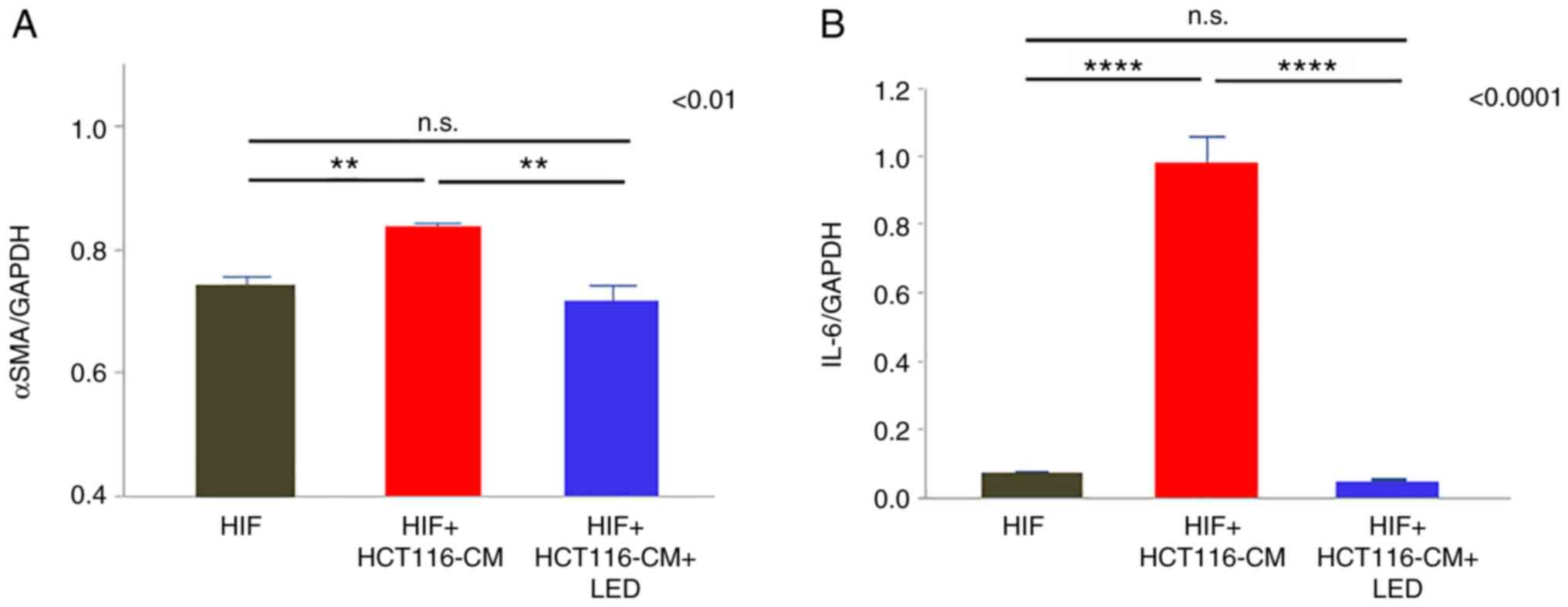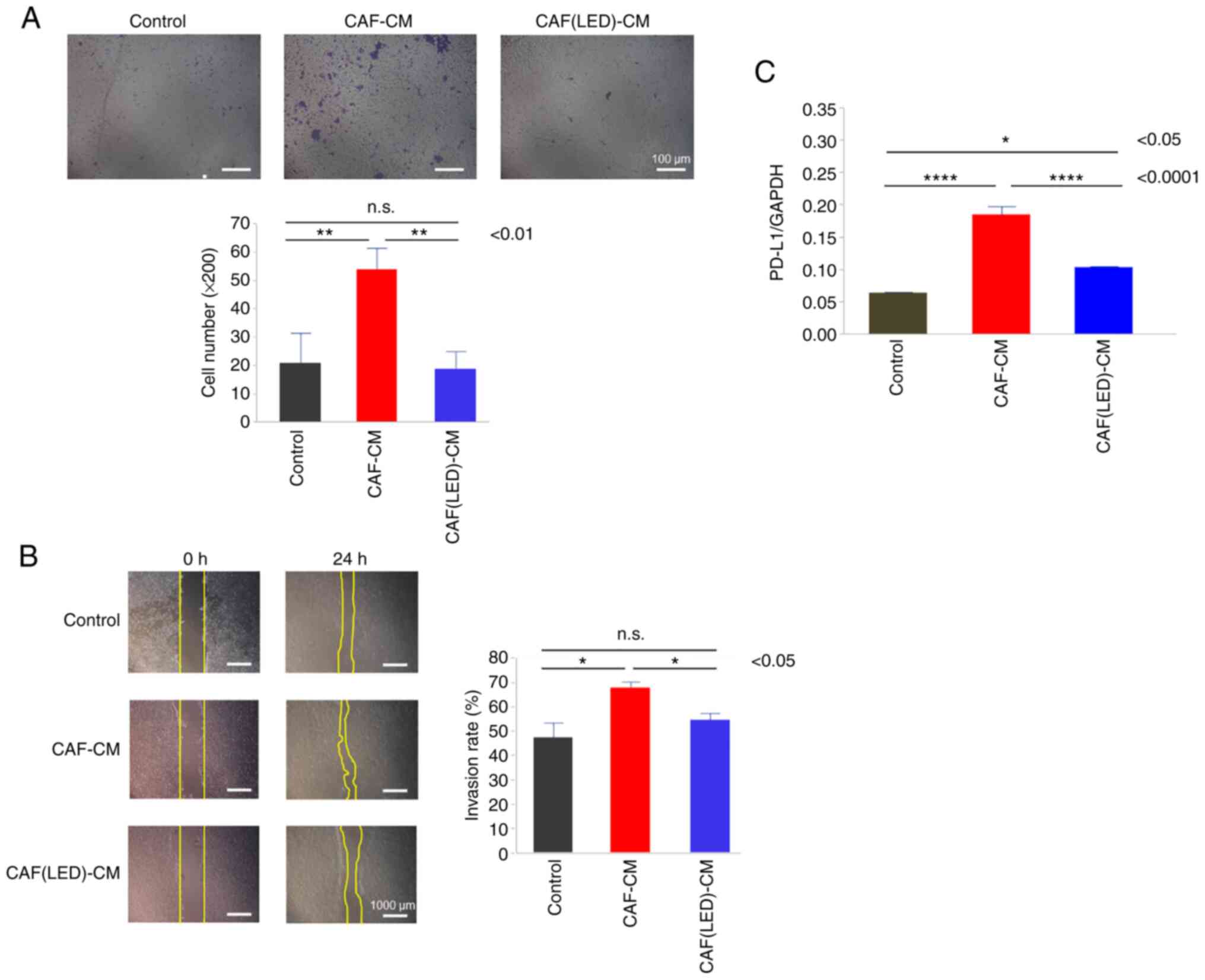Blue light irradiation inhibits the growth of colon cancer and activation of cancer‑associated fibroblasts
- Authors:
- Published online on: April 12, 2022 https://doi.org/10.3892/or.2022.8315
- Article Number: 104
-
Copyright: © Yoshimoto et al. This is an open access article distributed under the terms of Creative Commons Attribution License.
Abstract
Introduction
Irradiation with specific wavelengths of light using light-emitting diodes (LEDs) has several different effects on living cells and organisms. In the field of anticancer treatment, photodynamic therapy (PDT) and photothermal therapy (PTT), which combines LED light with photosensitizers, have been developed. PDT has gained attention as a novel minimally invasive alternative therapy to chemoradiotherapy and it is being used for cancers such as skin cancer, prostate cancer, lung cancer, brain tumors, and esophageal cancer in clinical settings (1). There are also some reports on the effects of PDT and PTT on colorectal cancer in vitro and in vivo (2–4); however, blue LED light itself has been demonstrated to be effective in killing certain types of cells. Recent studies suggest that irradiation with blue visible light inhibits tumor growth in various cancer cell lines (5–8). The phototoxic and antiproliferative effects of blue light have been reported to cause apoptosis (7), autophagy (5), and cell cycle arrest (8). Blue LED irradiation also causes reactive oxygen species (ROS) production and DNA damage in colorectal cancer cells (9); however, the mechanism of photoreception in ‘nonvisual’ tumor cells is unknown. We previously reported that blue LED light irradiation at 465 nm (30 mW/cm2, 30 min) inhibits the proliferation of colon cancer cells through the autophagy pathway (10). Furthermore, we found that the photoreceptor opsin 3 (Opn3) promotes the cytostatic effect of blue LED light (10).
Opsin is a G protein-coupled receptor (GPCR) expressed in photoreceptors, such as retinal rods and cone cells. It is activated by light and is involved in neurotransmission via G proteins. In recent years, it has been revealed that Opn3 is widely expressed not only in the retina but also in organs unrelated to vision, such as the brain, respiratory epithelium, liver, kidney, and heart, and it is thus referred to as a nonvisual opsin (11,12). Opn3 functions as a receptor of blue light and regulates GPCR signaling (13). Opn3 has an absorption maximum at 460–470 nm and activates the Gi/o subtypes of G proteins, which inhibit adenylate cyclase and decrease cyclic adenosine monophosphate (cAMP) (13,14). Previous reports have shown that opsin is associated with phototherapy as a photoreceptor for malignant melanocytes (15), and we reported that Opn3 is associated with phototherapy as a photoreceptor in colon cancer cells (10). However, the role of photoreceptors in colorectal cancer in vivo and the effects of blue LED on the tumor microenvironment are unknown.
In recent years, it has become evident that not only tumor cells but also the tumor microenvironment, including fibroblasts and immune cells, are extremely important in cancer treatment. Fibroblasts are also activated by tumors to generate cancer-associated fibroblasts (CAFs) and secrete various cytokines, chemokines, growth factors and extracellular vesicles, and play an important role in crosstalk in the tumor microenvironment and increased tumor malignancy (16,17).
It has been reported that blue light significantly decreases fibroblast-induced α-SMA protein expression in fibroblastic diseases associated with elevated α-smooth muscle actin (α-SMA) expression (18), and it has been suggested that blue LED irradiation is a useful tool for not only fibroblastic diseases but also the tumor microenvironment.
The aim of this study was to investigate the impact of blue LED light on colon cancer and the tumor microenvironment and to examine the contribution of photoreceptors in vivo.
Materials and methods
Cell culture
The human colon cancer cell lines HCT-116 and HT-29 (KAC Co., Ltd.; cat nos. EC91091005-F0 and EC91072201-F0) and human intestinal fibroblasts (ScienCell Research Laboratories, Inc.; cat. no. 2920) were used for in vitro and in vivo experiments. The cells were tested for mycoplasma and confirmed to be negative, and the cell lines were maintained and cultured in accordance with international guidelines for proper cell culture practices. The cells were cultured in RPMI-1640 medium (Wako Pure Chemical Industries, Ltd.) supplemented with 10% fetal bovine serum (FBS), 100 U/ml penicillin, and 100 µg/ml streptomycin (Sigma-Adrich; Merck KGaA) in a 37°C humidified incubator containing 5% CO2.
Animals
Sixteen 4 weeks old female nude mice (BALB/c) were purchased from Charles River Japan, Inc. (Kanagawa, Japan). The average weight of the mice used was 18.2±0.6 g. During the experiment, the animals were maintained behind barriers under controlled conditions and provided with water and a standard laboratory diet for at least 7 days before use. The animals had free access to tap water and food before and after surgery. Two weeks after irradiation, the mice were sacrificed by cervical dislocation and the tumors were removed for tissue processing.
The research was conducted in compliance with the Division for Animal Research Resources, Institute of Health Biosciences, University of Tokushima, Japan. The experiments and procedures were approved by the Animal Care and Use Committee of the University of Tokushima, Japan. All animal experiments were performed in accordance with the U.K. Animals (Scientific Procedures) Act, 1986 and associated guidelines (https://www.legislation.gov.uk/ukpga/1986/14/contents), EU Directive 2010/63/EU for animal experiments (https://eur-lex.europa.eu/legal-content/EN/TXT/PDF/?uri=CELEX:32010L0063), and the National Institutes of Health Guide for the Care and Use of Laboratory Animals (NIH Publications No. 8023, revised 1978) (https://grants.nih.gov/grants/olaw/Guide-for-the-Care-and-use-of-laboratory-animals.pdf).
Orthotopic model
HCT-116 cells were harvested with 1 mM ethylenediaminetetraacetic acid in phosphate-buffered saline (PBS), washed three times with PBS, and resuspended at a density of 1×107 cells/ml in PBS containing 500 mg/ml of Matrigel (Becton Dickinson Labware). Animals were anesthetized with ether and then placed in a supine position. A 7-mm incision was made in the anterior rectal wall to prevent colonic obstruction caused by rectal tumor progression. Suspended HCT-116 cells (1×106) were slowly injected into the submucosa of the posterior rectal wall using a 29-gauge needle. Long and short diameters of the primary tumor mass were measured every week after tumor implantation. Tumor volume was calculated using the following formula: Tumor volume (mm3) =1/2×(long diameter)x(short diameter)2.
LED irradiation
Sixteen mice developed rectal cancer at 7 days after cell implantation and were randomized into four experimental groups comprising four animals each and irradiated as in the following settings in accordance with our previous reports (10,19): i) LED irradiation (465 nm, 30 mW/cm2, 30 min, once) group sacrificed 2 weeks after cell implantation; ii) LED irradiation (465 nm, 30 mW/cm2, 30 min, 1 day/week) group sacrificed 3 weeks after cell implantation; iii) control group sacrificed 2 weeks after cell implantation; iv) control group sacrificed 3 weeks after cell implantation (Fig. 1A). The blue LED light was irradiated onto the tumor from the surface of the skin without any surgical procedure.
Immunohistochemistry
The tissues resected from the orthotopic model or cultured cells were fixed in 10% formalin (Wako Pure Chemical Industries, Ltd.; cat. no. 066-03847) for 24 h at room temperature, paraffin-embedded, and sliced to 4-µm thickness. Next, 3% BSA (MACS® BSA Stock Solution; MACS Miltenyi Biotec; cat. no. 130-091-376) was used for blocking for 1 h at room temperature, and the anti-β-arrestin 1 antibody (15361-1-AP; Proteintech; dilution 1:100), anti-Opn3 antibody (SAB2700986; Sigma-Adrich; Merck KGaA; dilution 1:250), anti-TGF-β antibody (SAB4502954; Sigma-Adrich; Merck KGaA; dilution 1:200) and anti-α-SMA antibody (ab7817; Abcam K.K.; dilution 1:100) were used for immunostaining. Secondary antibodies were Alexa Flour® 594 goat anti-mouse lgG (A11005; Abcam K.K.; dilution 1:500) or Alexa Flour® 488 goat anti-rabbit lgG (A11008; Abcam K.K. dilution 1:500) for 1 h at room temperature. A KEYENCE BZ-710 fluorescence microscope (Keyence, Osaka, Japan) with ×20 or ×40 magnification was used for imaging.
RT-PCR analysis
Total RNA was isolated using the RNeasy Mini Kit (Qiagen GmbH) and was reverse transcribed using a high-capacity cDNA reverse transcription kit (Applied Biosystems; Thermo Fisher Scientific, Inc.). The 7500 real-time PCR system, TaqMan gene expression assays on demand, and TaqMan universal master mix (Applied Biosystems; Thermo Fisher Scientific, Inc.) were used to perform quantitative real-time PCR. The following TaqMan primers (identification number) were used: LC-3 (Hs01076567_g1), beclin-1 (Hs01061917_g1), α-SMA (Hs00426835_g1), IL-6 (Hs00985639_m1), and PD-L1 (Hs00204257_m1). GAPDH (4326317E) was used as an internal control for mRNA expression (all from Applied Biosystems; Thermo Fisher Scientific, Inc.). The thermal cycling conditions were as follows: 2 min at 50°C, 10 min at 95°C, and then 40 cycles of 15 sec at 95°C followed by 1 min at 60°C. Amplification data were analyzed using the Prism 7500 Sequence Detection System ver. 1.3.1 (Applied Biosystems; Thermo Fisher Scientific, Inc.). The Step One Plus Real-Time PCR System (Applied Biosystems; Thermo Fisher Scientific, Inc.) was used to perform RT-qPCR. The relative abundance of target transcripts was evaluated and normalized to the expression of GAPDH as an internal control using the 2−ΔΔCq method (20).
Preparation of the conditioned medium (CM)
HCT-116 cells were cultured in a 10-cm dish up to 80% confluency. The cells were washed with PBS and then incubated in FBS-free medium. After 48 h of incubation, the medium was collected, centrifuged (750 × g, 10 min), and passed through a 0.2-µm filter to obtain cancer cell-CM. The CM was used without additional FBS. CAF-derived cancer cell-CM was prepared by adding cancer cell-CM to human intestinal fibroblasts for 48 h. The CAFs of the irradiation group were treated with blue LED light (465 nm, 30 mW/cm2, 30 min). Next, the medium was changed once and the supernatant was collected. These supernatants were used as CAF-CM (Fig. 1B).
Migration and scratch assays
Transwell inserts (Corning, Inc.) with an 8-µm pore size were used for the migration assays. Cancer cells (2.0×104) were seeded into the upper chamber. After cell attachment, the medium in the upper chambers was discarded and fresh medium containing 1% FBS was added. Each CM containing 10% FBS was added to the lower chamber. After incubation at 37°C for 24 h, the cells that migrated to the bottom of the Transwell membrane were fixed with 4% paraformaldehyde for 15 min, stained with 0.2% crystal violet solution (Wako Pure Chemical Industries, Ltd.) for 20 min at room temperature, and examined under a phase contrast microscope (BX43; Olympus Corp.). The stained cells were counted in three random fields per membrane (×100 magnification).
For the scratch assays, cancer cells were seeded at a density of 2.0×104 cells/well in 6-well plates. Once the cells attained confluency, a plastic pipette tip was scraped across the center of the well to produce a 1-mm wide wound area. The medium was discarded and then replenished with fresh DMEM medium containing 1% FBS followed by the addition of corresponding CM at a ratio of 1:1; the final FBS concentration was 0.5%, and the cancer cells were cultured for a further 24 h at 37°C. Images of the wound areas were captured using a phase-contrast microscope (magnification, ×40; DP22-CU; Olympus Corp.) at 0 and 24 h after scratching. The wound healing rates were calculated using ImageJ v1.46r software (National Institutes of Health) and using the following equation: Wound healing rate (%)=[area (0 h)-area (24 h)]/area (0 h) ×100.
Statistical analysis
All statistical analyses were performed using Stat View version 5.0 software (SAS Institute). The Mann-Whitney U-test and Wilcoxon signed-rank test were used for statistical comparisons. Subsequently, the multiple comparisons were assessed by Dunnett or Tukey's test. P-values of <0.05 were considered statistically significant.
Results
Opn3 expression in colon cancer
Opn3 expression was observed in colon cancer cells by immunohistochemistry. No Opn3 expression was detected in normal intestinal epithelial cells, whereas diffuse Opn3 expression was observed in the cytoplasm of tumor cells (Fig. 2A).
Effects of blue LED irradiation on colon cancer
Two weeks after the start of irradiation, the growth of colon tumors was suppressed by blue LED irradiation (P=0.048) (Fig. 2B). The largest tumor diameter and volume were 15 mm and 750 mm3, respectively. Regarding morphological changes, the tumor cells were found to be swollen near the tumor surface following LED irradiation (Fig. 2C). In the control group, Opn3 expression was diffuse throughout the cytoplasm, whereas in the irradiation group, Opn3 expression was observed at the cell membrane (Fig. 3A). Using immunostaining, the localization of Opn3 was evaluated by the stained area relative to the cytoplasm, and the stained area was significantly decreased in the irradiated group (P<0.01). When this phenomenon was examined in vitro by immunostaining, Opn3 expression was diffuse throughout the cytoplasm in both colon cancer cell lines in the control group and localized to the cell membrane in the LED group (Fig. 3B). Arrestin was also expressed in the cytoplasm of the control group, and it was observed on the cell membrane of the LED group in fluorescent immunostaining of the orthotopic models (Fig. 3C). In addition, immunostaining was performed and the results revealed that transforming growth factor (TGF)-β and α-SMA expression levels in the fibroblasts were attenuated in the LED group (TGF-β: P=0.035, α-SMA: P=0.022) (Fig. 4).
Blue LED irradiation induces the upregulation of autophagy-related factors
The expression levels of the LC-3 and beclin-1 genes were analyzed by RT-PCR at 1 week following LED irradiation. RNA levels of LC-3 (P=0.0025) and beclin-1 (P=0.031) were significantly elevated in the LED group compared with those in the control group (Fig. 5A and B).
Blue LED irradiation suppresses the CAF activation in vitro
α-SMA and IL-6 expression in the CAFs was evaluated by PCR. α-SMA expression was attenuated by blue LED irradiation (P=0.0036) (Fig. 6A) and IL-6 expression was significantly decreased in the LED group (P<0.0001) (Fig. 6B). Furthermore, migration (Fig. 7A) and scratch assays (Fig. 7B) for HCT-116 cells cultured in CAF-CM were performed. CAF-CM promoted the migration and invasion by HCT-116 cells. In contrast, compared with CAF-CM, CAF-CM derived from LED-irradiated CAF did not promote the migration or invasion of HCT-116 cells (P=0.0053 and P=0.019, respectively).
Finally, the expression of PD-L1 in HCT-116 cells was evaluated by PCR. PD-L1 expression was increased in the HCT-116 cells cultured in CAF-CM compared to the control group (P<0.0001); however, the relative increase in PD-L1 expression was lower in the CAFs irradiated with blue LED light than that in the CAFs without LED irradiation (P<0.0001) (Fig. 7C).
Discussion
It has been reported that radiation therapy, photodynamic therapy (PDT), and phototherapy induce autophagy in colon cancer cells (21). Recently, we reported that blue light-emitting diode (LED) light irradiation at 465 nm (30 mW/cm2, 30 min) induced autophagy via opsin 3 (Opn3) and coupled G protein in colon cancer cells (10). In the present study, irradiation for 30 min with LED light at 465 nm suppressed tumor growth in human colon cancer, and autophagy was determined to be the mechanism underlying growth suppression in vivo. Furthermore, Opn3 was diffusely expressed throughout the cytoplasm of colon cancer cells in the control group but strongly expressed in the cell membrane of the LED group. Opn3 is known as a blue light receptor that is widely expressed in nonvisual cells (22). It is predicted that Opn3 must be expressed in the cell membrane to function as a photoreceptor, and the translocation of opsins from the cytoplasm to the cell membrane in melanocytes has been reported (15). These results suggest that irradiation with blue LED light induces Opn3 translocation from the cytoplasm to the cell membrane where Opn3 acts as a photoreceptor. Cell membrane-associated Opn3 may then promote autophagy in colon cancer cells. It is known that arrestin inactivates opsin expressed in the cell membrane of photoreceptors by drawing it into the cytoplasm (23). In the present study, arrestin was also diffusely expressed in the cytoplasm of the controls and localized to the cell membrane following blue LED irradiation. These results suggest that arrestin is also involved in the migration of Opn3 into colorectal cancer cells.
Previous reports have shown that autophagy may induce caspase-independent cell death and inhibit tumor growth (24). In addition, autophagy was negatively regulated by cAMP signaling (25,26). Irradiated Opn3 activates the Gi/o subtype of the G proteins which inhibits cAMP activation. Based on these findings, blue LED irradiation may induce autophagy and inhibit the growth of colon cancer cells via the Opn3 photoreceptor pathway. In addition, we previously found that Opn3 protein was highly expressed in human colon cancer cells and no expression of Opn3 was observed in human normal colonic mucosa (10). Also in the present in vivo experiments, Opn3 was not expressed in the normal colonic mucosa, and since the tumor-suppressive effect of blue LED was canceled when Opn3 was knocked down in a previous study, it is considered that there is no Opn3-mediated cytotoxicity to the normal mucosa. These findings indicate that blue light irradiation can be used clinically for the treatment of colon cancer.
In recent years, it has been determined that the tumor microenvironment, including not only tumor cells but also fibroblasts and immune cells, is extremely important to the efficacy of anticancer therapy. Fibroblasts are also activated by cancer cells and become cancer-associated fibroblasts (CAFs). Transforming growth factor (TGF)-β and Interleukin (IL)-6 are markers of CAFs (27), and CAFs contribute to the malignant phenotype. In a previous study, we also reported that IL-6 in the tumor microenvironment increases malignancy (28,29). In the present study, immunostaining for TGF-β and α-smooth muscle actin (α-SMA) revealed that their expression in fibroblasts in the tumor microenvironment was attenuated in the LED group, which suggests the use of phototherapy to target the tumor microenvironment, including CAFs. We found that LED irradiation on CAFs not only reduced the migration and invasion ability of colorectal cancer cells, but also had no cell proliferation-promoting effect in the conditioned medium (CM) of LED-irradiated CAFs (data not shown).
An in vitro study also showed the effects of LEDs that suppress CAF activation and IL-6 expression. It has been reported that IL-6 increases programmed cell death 1-ligand (PD-L1) expression via STAT3 (30). Therefore, we considered the possibility that blue light suppresses the activation of CAFs as well as tumor cells, further reducing tumor malignancy. Consequently, LED irradiation of CAFs indirectly reduced tumor malignancy and suppressed PD-L1 expression in the HCT-116 cells. PD-L1 expression in the colon cancer cells was also reduced by LED irradiation on CAFs in vitro. It has been reported that the expression of TGF-β in the tumor microenvironment correlates with PD-L1 expression in cancer cells and is closely related to tumor immunity (31). Thus, blue LED may exert antitumor effects by influencing tumor immunity.
The major limitation of this study is that the significance of Opn3 expression in tumors and fibroblasts has not been fully investigated because we have not conducted experiments with tumors without Opn3 or Opn3-knockout mice. In addition, since we were unable to collect the amount of samples necessary for the evaluation of protein expression in this in vivo experiment, it is necessary to conduct the experiment again to examine protein expression levels such as LC-3, Beclin1, PDL-1, aSMA and IL-6. In our previous in vitro studies, daily irradiation for 5 min and once-irradiation for 30 min were used (10,19), and similar tumor suppressive effects were observed. Therefore, weekly irradiation for 30 min was used in vivo this time. In the future, it will be necessary to study the effects of short-duration divided irradiation and multiple 30-min irradiation sessions.
The mechanism by which blue light suppresses CAFs is unclear, and there are no reports of photoreceptor-mediated effects, thus the role of photoreceptors in CAFs is an important issue for future investigation. Although further studies are warranted to elucidate the mechanism of action of blue LED irradiation on tumors and the microenvironment, including Opn3 expression, translocation and photoimmunotherapeutic effects, this study suggests that blue LED irradiation may have an inhibitory effect on colorectal cancer and the tumor microenvironment.
Acknowledgements
Not applicable.
Funding
Funding: No funding has been received.
Availability of data and materials
The datasets used during the present study are available from the corresponding author upon reasonable request.
Authors' contributions
TY, SO and MS conceived and designed the study. TY, SO, HK and YW performed the experiments and collected the data. TY, SO, MN and CT analyzed and interpreted the data. TY and SO wrote the paper. TT, TN, and MN reviewed the data and information and edited the manuscript. KY and MS revised the paper critically for important intellectual content. KY, TY and TT confirmed the authenticity of all the raw data. All authors read and approved the manuscript and agree to be accountable for all aspects of the research in ensuring that the accuracy or integrity of any part of the work are appropriately investigated and resolved.
Ethics approval and consent to participate
The research was conducted in compliance with the Division for Animal Research Resources, Institute of Health Biosciences, University of Tokushima, Japan. The experiments and procedures were approved by the Animal Care and Use Committee of the University of Tokushima, Japan.
Patient consent for publication
Not applicable.
Competing interests
The authors declare no competing interests.
Glossary
Abbreviations
Abbreviations:
|
LED |
light-emitting diode |
|
CAFs |
cancer-associated fibroblasts |
|
CM |
conditioned medium |
|
HIFs |
human intestinal fibroblasts |
|
Opn3 |
opsin 3 |
|
cAMP |
cyclic adenosine monophosphate |
|
GPCR |
G protein-coupled receptors |
|
PDT |
photodynamic therapy |
|
PTT |
photothermal therapy |
|
PD-L1 |
programmed cell death 1-ligand |
|
α-SMA |
α-smooth muscle actin |
|
TGF |
transforming growth factor |
References
|
Gunaydin G, Gedik ME and Ayan S: Photodynamic therapy for the treatment and diagnosis of cancer-a review of the current clinical status. Front Chem. 9:6863032021. View Article : Google Scholar : PubMed/NCBI | |
|
Hatakeyama T, Murayama Y, Komatsu S, Shiozaki A, Kuriu Y, Ikoma H, Nakanishi M, Ichikawa D, Fujiwara H, Okamoto K, et al: Efficacy of 5-aminolevulinic acid-mediated photodynamic therapy using light-emitting diodes in human colon cancer cells. Oncol Rep. 29:911–916. 2013. View Article : Google Scholar : PubMed/NCBI | |
|
Hodgkinson N, Kruger CA and Abrahamse H: Targeted photodynamic therapy as potential treatment modality for the eradication of colon cancer and colon cancer stem cells. Tumor Biology. 39:10104283177346912017. View Article : Google Scholar : PubMed/NCBI | |
|
Yan J, Wang C, Jiang X, Wei Y, Wang Q, Cui K, Xu X, Wang F and Zhang L: Application of phototherapeutic-based nanoparticles in colorectal cancer. Int J Biol Sci. 17:1361–1381. 2021. View Article : Google Scholar : PubMed/NCBI | |
|
Oh PS, Hwang H, Jeong HS, Kwon J, Kim HS, Kim M, Lim S, Sohn MH and Jeong HJ: Blue light emitting diode induces apoptosis in lymphoid cells by stimulating autophagy. Int J Biochem Cell Biol. 70:13–22. 2016. View Article : Google Scholar : PubMed/NCBI | |
|
del Olmo-Aguado S, Núñez-Álvarez C and Osborne NN: Blue light action on mitochondria leads to cell death by necroptosis. Neurochem Res. 41:2324–2335. 2016. View Article : Google Scholar : PubMed/NCBI | |
|
Oh PS, Na KS, Hwang H, Jeong HS, Lim S, Sohn MH and Jeong HJ: Effect of blue light emitting diodes on melanoma cells: Involvement of apoptotic signaling. J Photochem Photobiol B. 142:197–203. 2015. View Article : Google Scholar : PubMed/NCBI | |
|
Sparsa A, Faucher K, Sol V, Durox H, Boulinguez S, Doffoel-Hantz V, Calliste CA, Cook-Moreau J, Krausz P, Sturtz FG, et al: Blue light is phototoxic for B16F10 murine melanoma and bovine endothelial cell lines by direct cytocidal effect. Anticancer Res. 30:143–147. 2010.PubMed/NCBI | |
|
Yan G, Zhang L, Feng C, Gong R, Idiiatullina E, Huang Q, He M, Guo S, Yang F, Li Y, et al: Blue light emitting diodes irradiation causes cell death in colorectal cancer by inducing ROS production and DNA damage. Int J Biochem Cell Biol. 103:81–88. 2018. View Article : Google Scholar : PubMed/NCBI | |
|
Yoshimoto T, Morine Y, Takasu C, Feng R, Ikemoto T, Yoshikawa K, Iwahashi S, Saito Y, Kashihara H, Akutagawa M, et al: Blue light-emitting diodes induce autophagy in colon cancer cells by Opsin 3. Ann Gastroenterol Surg. 2:154–161. 2018. View Article : Google Scholar : PubMed/NCBI | |
|
Koyanagi M and Terakita A: Diversity of animal opsin-based pigments and their optogenetic potential. Biochim Biophys Acta. 1837:710–716. 2014. View Article : Google Scholar : PubMed/NCBI | |
|
Jiao J, Hong S, Zhang J, Ma L, Sun Y, Zhang D, Shen B and Zhu C: Opsin3 sensitizes hepatocellular carcinoma cells to 5-fluorouracil treatment by regulating the apoptotic pathway. Cancer Lett. 320:96–103. 2012. View Article : Google Scholar : PubMed/NCBI | |
|
Koyanagi M, Takada E, Nagata T, Tsukamoto H and Terakita A: Homologs of vertebrate Opn3 potentially serve as a light sensor in nonphotoreceptive tissue. Proc Natl Acad Sci USA. 110:4998–5003. 2013. View Article : Google Scholar : PubMed/NCBI | |
|
Terakita A and Nagata T: Functional properties of opsins and their contribution to light-sensing physiology. Zoolog Sci. 31:653–659. 2014. View Article : Google Scholar : PubMed/NCBI | |
|
de Assis L, Moraes M, da Silveira Cruz-Machado S and Castrucci AM: The effect of white light on normal and malignant murine melanocytes: A link between opsins, clock genes, and melanogenesis. Biochim Biophys Acta. 1863:1119–1133. 2016. View Article : Google Scholar : PubMed/NCBI | |
|
Berzaghi R, Islam A, Hellevik T and Martinez-Zubiaurre I: Secretion rates and protein composition of extracellular vesicles released by cancer-associated fibroblasts after radiation. J Radiat Res. 62:401–413. 2021. View Article : Google Scholar : PubMed/NCBI | |
|
Ham IH, Lee D and Hur H: Cancer-associated fibroblast-induced resistance to chemotherapy and radiotherapy in gastrointestinal cancers. Cancers (Basel). 13:11722021. View Article : Google Scholar : PubMed/NCBI | |
|
Krassovka J, Borgschulze A, Sahlender B, Lögters T, Windolf J and Grotheer V: Blue light irradiation and its beneficial effect on Dupuytren's fibroblasts. PLoS One. 14:e02098332019. View Article : Google Scholar : PubMed/NCBI | |
|
Matsumoto N, Yoshikawa K, Shimada M, Kurita N, Sato H, Iwata T, Higashijima J, Chikakiyo M, Nishi M, Kashihara H, et al: Effect of light irradiation by light emitting diode on colon cancer cells. Anticancer Res. 34:4709–4716. 2014.PubMed/NCBI | |
|
Livak KJ and Schmittgen TD: Analysis of relative gene expression data using real-time quantitative PCR and the 2(−Delta Delta C(T)) method. Methods. 25:402–408. 2001. View Article : Google Scholar : PubMed/NCBI | |
|
Zhang B and Liu L: Autophagy is a double edged sword in the therapy of colorectal cancer. Oncol Lett. 21:3782021. View Article : Google Scholar : PubMed/NCBI | |
|
Sakai K, Yamashita T, Imamoto Y and Shichida Y: Diversity of active states in TMT opsins. PLoS One. 10:e01412382015. View Article : Google Scholar : PubMed/NCBI | |
|
Luttrell LM and Lefkowitz RJ: The role of β-arrestins in the termination and transduction of G-protein-coupled receptor signals. J Cell Sci. 115:455–465. 2002. View Article : Google Scholar : PubMed/NCBI | |
|
Mathew R, Karp CM, Beaudoin B, Vuong N, Chen G, Chen HY, Bray K, Reddy A, Bhanot G, Gelinas C, et al: Autophagy suppresses tumorigenesis through elimination of p62. Cell. 137:1062–1075. 2009. View Article : Google Scholar : PubMed/NCBI | |
|
Park JY and Juhnn YS: cAMP signaling increases histone deacetylase 8 expression by inhibiting JNK-dependent degradation via autophagy and the proteasome system in H1299 lung cancer cells. Biochem Biophys Res Commun. 470:336–342. 2016. View Article : Google Scholar : PubMed/NCBI | |
|
Kang R, Zeh H, Lotze M and Tang D: The Beclin 1 network regulates autophagy and apoptosis. Cell Death Differ. 18:571–580. 2011. View Article : Google Scholar : PubMed/NCBI | |
|
Jia C, Wang G, Wang T, Fu B, Zhang Y, Huang L, Deng Y, Chen G, Wu X, Chen J, et al: Cancer-associated fibroblasts induce epithelial-mesenchymal transition via the transglutaminase 2-dependent IL-6/IL6R/STAT3 axis in hepatocellular carcinoma. Int J Biol Sci. 16:2542–2558. 2020. View Article : Google Scholar : PubMed/NCBI | |
|
Feng R, Morine Y, Ikemoto T, Imura S, Iwahashi S, Saito Y and Shimada M: Nab-paclitaxel interrupts cancer-stromal interaction through C-X-C motif chemokine 10-mediated interleukin-6 downregulation in vitro. Cancer Sci. 109:2509–2519. 2018. View Article : Google Scholar : PubMed/NCBI | |
|
Iwahasi S, Rui F, Morine Y, Yamada S, Saito Y, Ikemoto T, Imura S and Shimada M: Hepatic stellate cells contribute to the tumor malignancy of hepatocellular carcinoma through the IL-6 pathway. Anticancer Res. 40:743–749. 2020. View Article : Google Scholar : PubMed/NCBI | |
|
Zhang W, Liu Y, Yan Z, Yang H, Sun W, Yao Y, Chen Y and Jiang R: IL-6 promotes PD-L1 expression in monocytes and macrophages by decreasing protein tyrosine phosphatase receptor type O expression in human hepatocellular carcinoma. J Immunother Cancer. 8:e0002852020. View Article : Google Scholar : PubMed/NCBI | |
|
Shima T, Shimoda M, Shigenobu T, Ohtsuka T, Nishimura T, Emoto K, Hayashi Y, Iwasaki T, Abe T, Asamura H and Kanai Y: Infiltration of tumor-associated macrophages is involved in tumor programmed death-ligand 1 expression in early lung adenocarcinoma. Cancer Sci. 111:727–738. 2020. View Article : Google Scholar : PubMed/NCBI |



